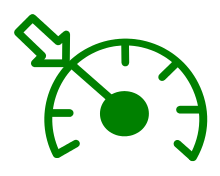Cruise control system

A cruise control system (engl GRA. Cruise control , as a) cruise control (trade name of Daimler AG ), cruise control ( Porsche is) a device in motor vehicles , which the rotational speed of the engine automatically controls that the vehicle is a predetermined from the driver speed possible, adheres to.
functionality
The regulation takes place in modern vehicles usually electronically by changing the torque. In the past, in addition to electrical controls, mechanical or pneumatic systems were mainly used, depending on whether the impulses from the accelerator pedal were transmitted electrically ( drive-by-wire ) or with a Bowden cable between the accelerator handle or accelerator pedal to the throttle valve. The control is deactivated when the handbrake or footbrake or the clutch (on some vehicles with manual transmission) are operated.
Additional speed limit function
In contrast to summer tires, winter tires are also allowed to use tires with a lower speed index that deviate from the information on the vehicle registration document . In many vehicles with a cruise control system, it is possible to activate a permanent speed limit for this.
In addition, a temporary speed limit can often be set that the driver can switch on and off at any time using the cruise control system. The speed limit prevents exceeding a limit set by the driver, e.g. B. 50 km / h in built-up areas.
Advantages and disadvantages
A cruise control system is particularly useful on motorways and roads with speed restrictions. It leads to more relaxed driving.
According to the vehicle manufacturers, there are no effects on fuel consumption. However, this only applies to the technical part of the control. A change in speed due to the use of a GRA results from the fact that a person cannot keep the speed as precisely at a constant level as the automatic control.
For physical reasons, at the same average speed, the fuel consumption when driving with a GRA is lower than when driving without it. The reason for this is that when driving manually, even with very experienced drivers, the speed is sometimes above and sometimes below the average speed. However, the energy consumption to overcome the air resistance grows quadratically with the speed. The parts of the route with speeds above the average speed lead to more fuel consumption than is saved in the parts of the route with below average speed. The same applies to acceleration: this results in additional consumption which (in contrast to the electric drive) cannot be regenerated when changing to slower driving.
The use of a GRA changes the driving style towards a steady driving style. The exact effects on fuel consumption have not been conclusively researched, although the EU has initiated studies on this.
It is sometimes assumed as a disadvantage that the risk of an accident may be increased due to the driver being less vigilant. Various studies on this topic do not confirm this. The Federal Highway Research Institute assesses the effects of a speed control system as positive overall.
Technical development
Cruise control systems were first used in automobiles in 1958 as cruise control at Chrysler , and in Europe for the first time in 1962 at Mercedes-Benz .
The first systems only acted on the gas actuation. A further development consists of the active braking of the vehicle when driving downhill. With automatic transmissions, a lower gear is selected in order to use the engine braking effect . In modern systems, in particular in manual transmissions, the cruise control system can initiate gentle braking with the service brake.
A modern variant is the distance-dependent adaptive cruise control, and adaptive cruise control called.
Legal Aspects
In Belgium, according to the signs, the use of cruise control is prohibited on some sections of the motorway near major cities, such as Antwerp (crossed out “Cruise Control” sign). However, it is questionable whether and how the Belgian police can review the ban.
See also
literature
- Karl-Heinz Dietsche, Thomas Jäger, Robert Bosch GmbH: Automotive pocket book. 25th edition. Friedr. Vieweg & Sohn Verlag, Wiesbaden 2003, ISBN 3-528-23876-3 .
- Hans-Hermann Braess, Ulrich Seiffert: Vieweg manual automotive technology. 2nd Edition. Friedrich Vieweg & Sohn Verlagsgesellschaft mbH, Braunschweig / Wiesbaden 2001, ISBN 3-528-13114-4 .
Individual evidence
- ↑ Information on the Tempomat brand in the register of the German Patent and Trademark Office (DPMA)
- ↑ bast.de ( page no longer available , search in web archives ) Info: The link was automatically marked as defective. Please check the link according to the instructions and then remove this notice. , Impact of cruise control on traffic safety, energy consumption and environmental pollution. April 2006
- ↑ Archived copy ( Memento of the original from November 28, 2011 in the Internet Archive ) Info: The archive link was inserted automatically and has not yet been checked. Please check the original and archive link according to the instructions and then remove this notice. , Effects of driving with cruise control and ACC on driver behavior.


